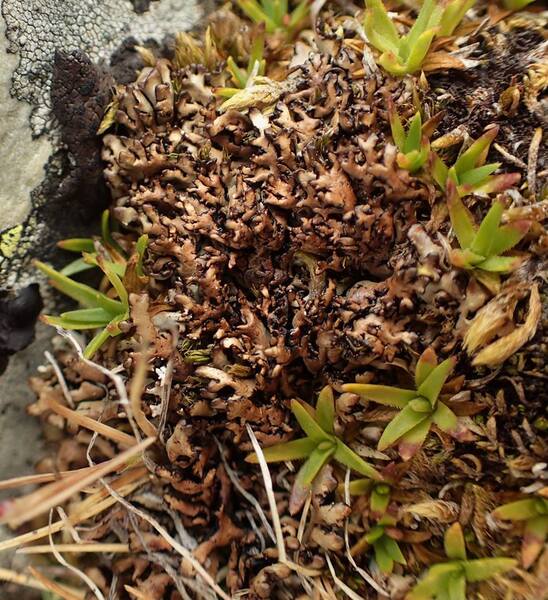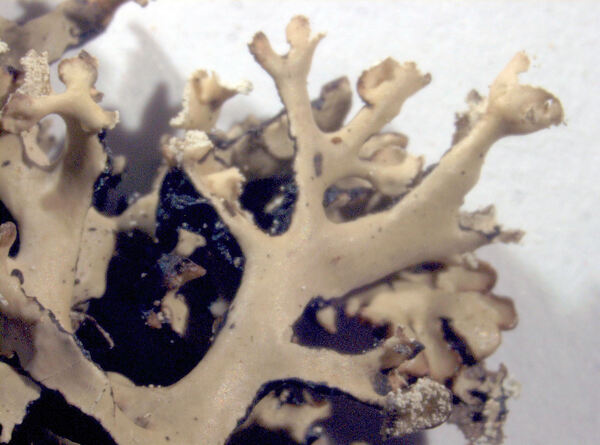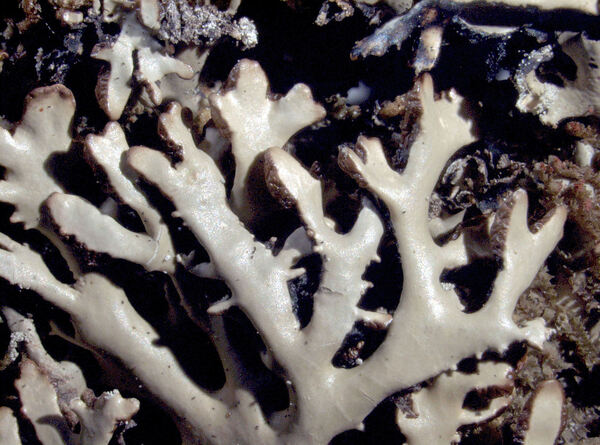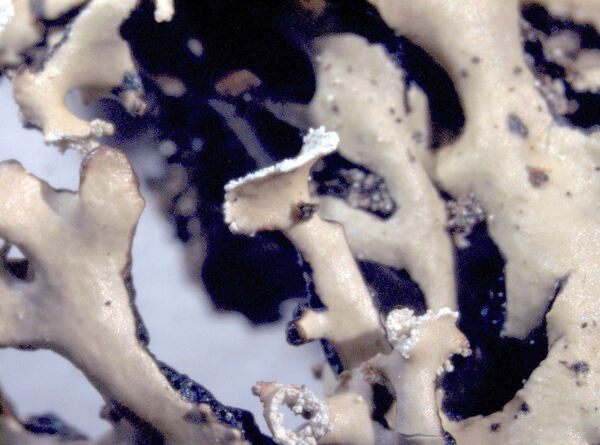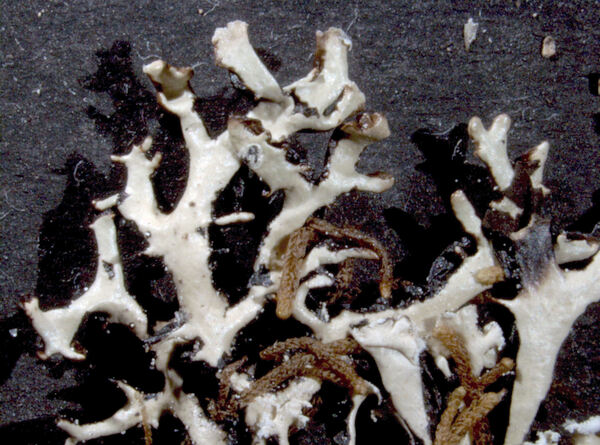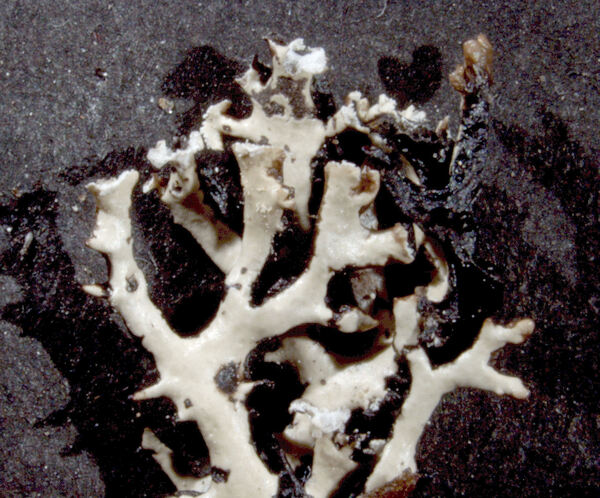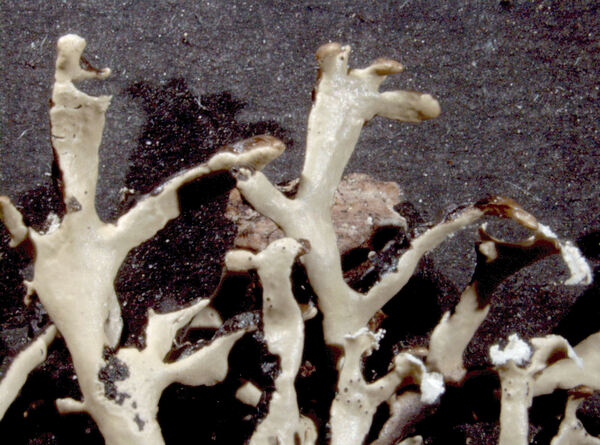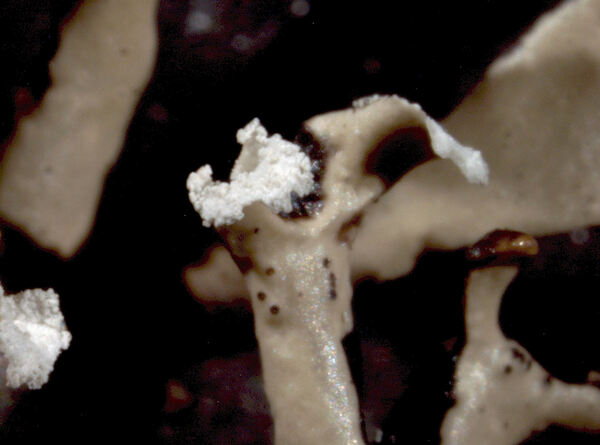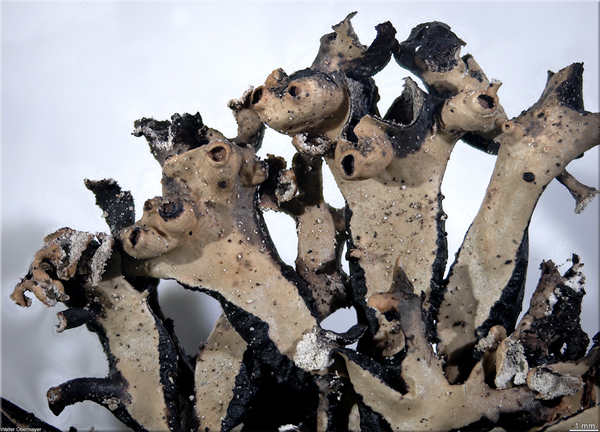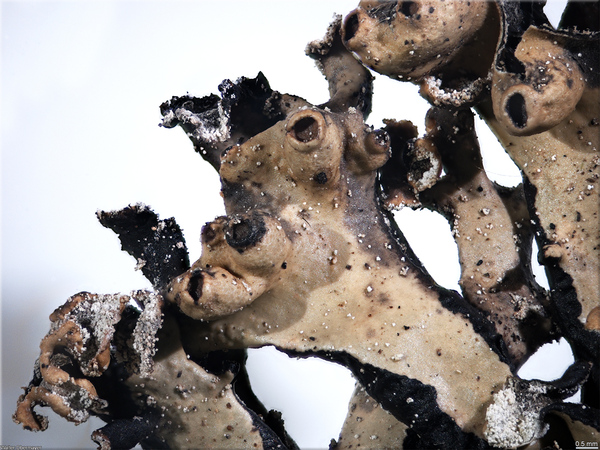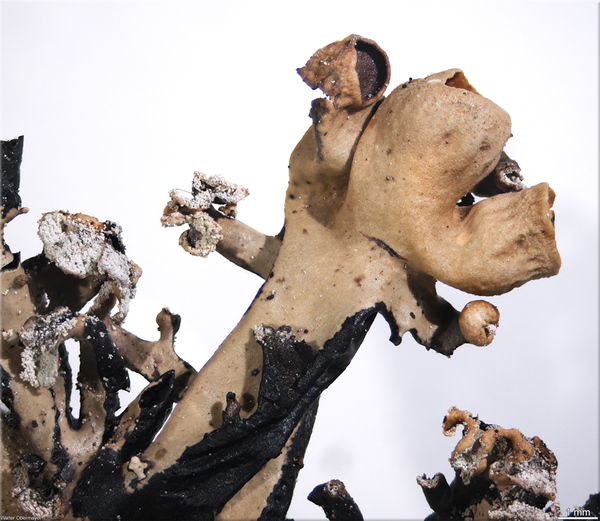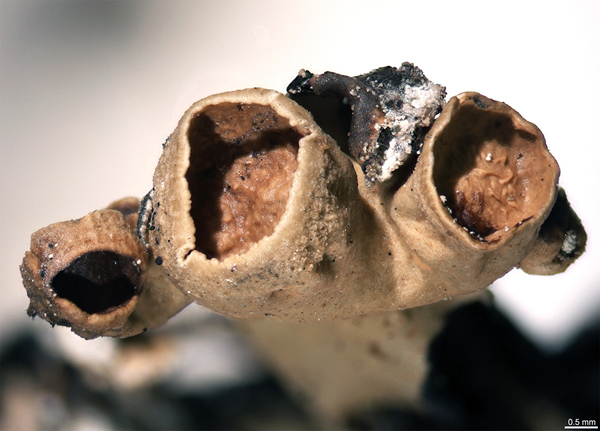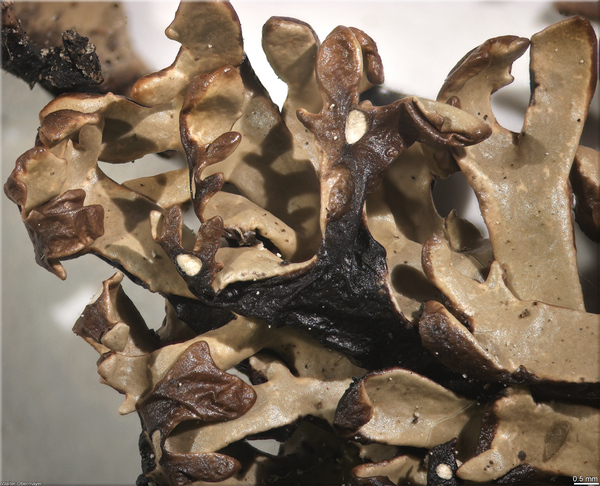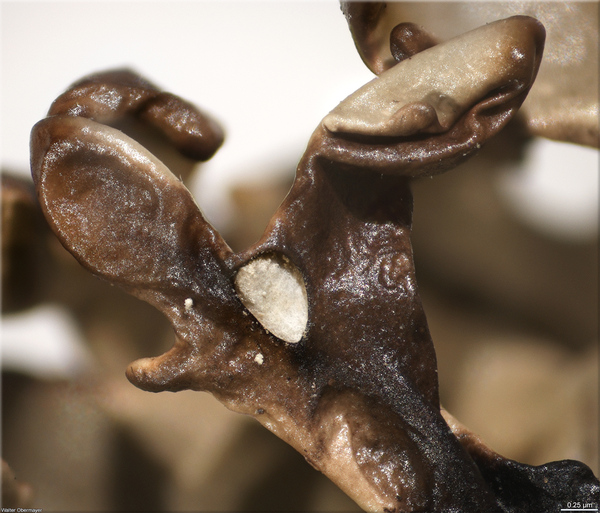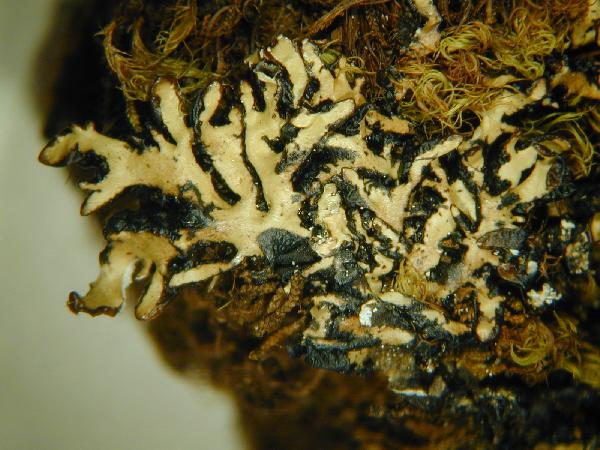Hypogymnia vittata (Ach.) Parrique
Act. Soc. Linn. Bordeaux, 53: 34, 1898. Basionym: Parmelia physodes var. vittata Ach. - Meth. Lich.: 251, 1803.
Synonyms: Imbricaria physodes var. vittata (Ach.) Körb.; Parmelia vittata (Ach.) Röhl.; Parmelia vittata var. alpestris Zahlbr.
Distribution: N - Frl, Ven (Nascimbene & Caniglia 2002c, 2003c, Nascimbene & al. 2009c, Nascimbene 2011), TAA (Nascimbene & Caniglia 2000b, 2002c, Nascimbene & al. 2006e, 2007b, 2022, Nascimbene 2014, Nimis & al. 2015, Pistocchi & al. 2024), Lomb (Zocchi & al. 1997), Piem (Isocrono & al. 2004).
Description: Thallus foliose to subfruticose, heteromerous, dorsiventral, at first loosely adnate, but often soon ascending or pendent, forming up to 10(-15)cm broad, irregular rosettes or irregularly spreading, the lobes swollen, hollow inside, 0.5-2(-3) mm wide, elongate, slender, irregularly branching, separate to imbricate, with small, marginal secondary lobules. Soredia terminal, at first labriform, then becoming strongly lacerate. Upper surface smooth to weakly rugose, whitish, greenish grey or sometimes partially brown, often with a black border. Lower surface black to brownish black, sparsely perforate near tips and at the branching points, erhizinate, often visible from above along lobe margins. Upper cortex of tightly packed, more or less anticlinally oriented hyphae, the cell walls with Cetraria-type lichenan; medulla soon becoming hollow, lining the cavity inside the lobes; lower cortex dark, paraplectenchymatous. Apothecia rare, lecanorine, mainly laminal, brought by hollow stipes, 6-8(10) mm across, with a brown disc. Epithecium brown; hymenium and hypothecium colourless; paraphyses coherent, simple or sparingly branched in upper part. Asci 8-spored, clavate, Lecanora-type. Ascospores 1-celled, hyaline, broadly ellipsoid, 4.5-7 x 4-5.5 μm. Pycnidia frequent, laminal, black, often in clusters. Conidia narrowly cylindrical to weakly bifusiform, 4.5-6.5 x c. 1 μm. Photobiont chlorococcoid. Spot tests: upper cortex K+ yellow, C-, KC-, P- or P+ pale yellow, UV-; medulla K-, C-, KC+ orange-red, P-, UV+ pale blue-violet. Chemistry: upper cortex with atranorin; medulla with physodic acid, 3-hydroxyphysodic acid (both major), and vittatolic acid (minor/accessory).Note: a circumboreal-montane lichen found on acid bark, often on basal parts of trunks, on acid soil and overgrowing moribund bryophytes, probably restricted to the Alps in Italy. It is included in the Italian red list of epiphytic lichens as “Vulnerable” (Nascimbene & al. 2013c).
Growth form: Foliose, narrow lobed
Substrata: bark
Photobiont: green algae other than Trentepohlia
Reproductive strategy: mainly asexual, by soredia, or soredia-like structures (e.g. blastidia)
Commonnes-rarity: (info)
Alpine belt: absent
Subalpine belt: very rare
Oromediterranean belt: absent
Montane belt: extremely rare
Submediterranean belt: absent
Padanian area: absent
Humid submediterranean belt: absent
Humid mediterranean belt: absent
Dry mediterranean belt: absent

Predictive model
Herbarium samples

André Aptroot; Owner: André Aptroot - Source: http://www.tropicallichens.net/ - Licence: CC BY-SA-NC
Taiwan
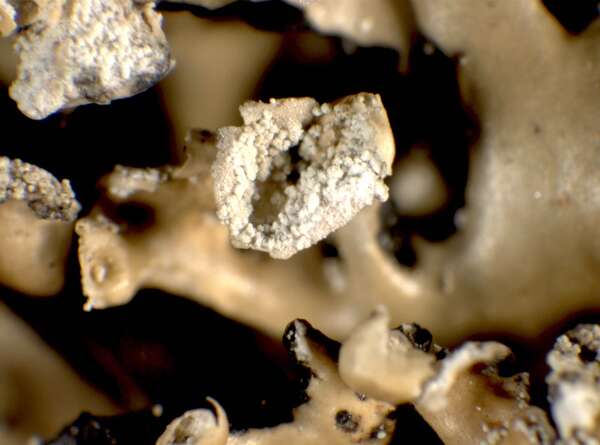

P.L. Nimis; Owner: Department of Life Sciences, University of Trieste
Herbarium: TSB (2539)
2001/12/12
soraliaum
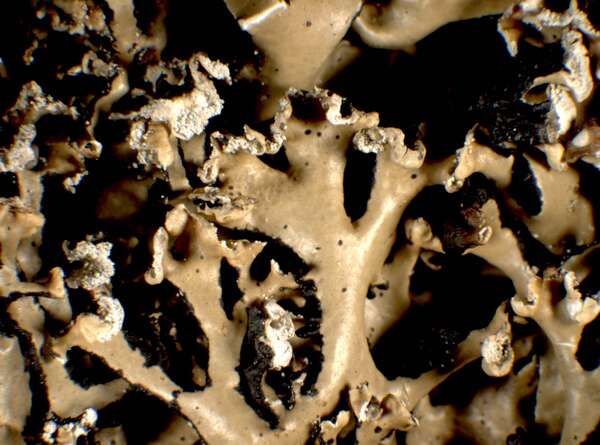

P.L. Nimis; Owner: Department of Life Sciences, University of Trieste
Herbarium: TSB (2539)
2001/12/12
Growth form: Foliose, narrow lobed
Substrata: bark
Photobiont: green algae other than Trentepohlia
Reproductive strategy: mainly asexual, by soredia, or soredia-like structures (e.g. blastidia)
Commonnes-rarity: (info)
Alpine belt: absent
Subalpine belt: very rare
Oromediterranean belt: absent
Montane belt: extremely rare
Submediterranean belt: absent
Padanian area: absent
Humid submediterranean belt: absent
Humid mediterranean belt: absent
Dry mediterranean belt: absent

Predictive model
| Herbarium samples |

André Aptroot; Owner: André Aptroot - Source: http://www.tropicallichens.net/ - Licence: CC BY-SA-NC
Taiwan


P.L. Nimis; Owner: Department of Life Sciences, University of Trieste
Herbarium: TSB (2539)
2001/12/12
soraliaum


 INDEX FUNGORUM
INDEX FUNGORUM
 GBIF
GBIF
 DOLICHENS
DOLICHENS



